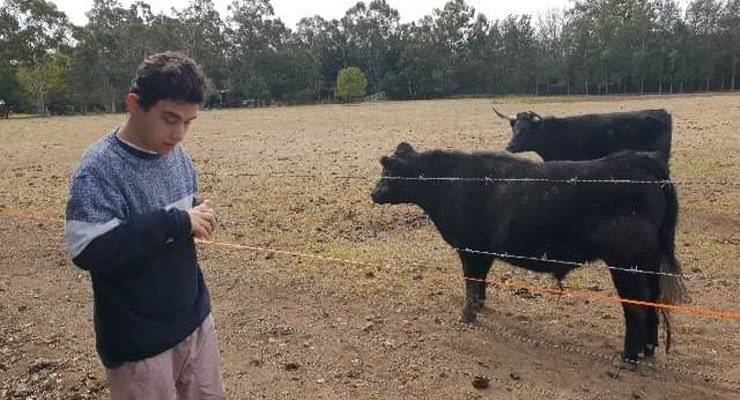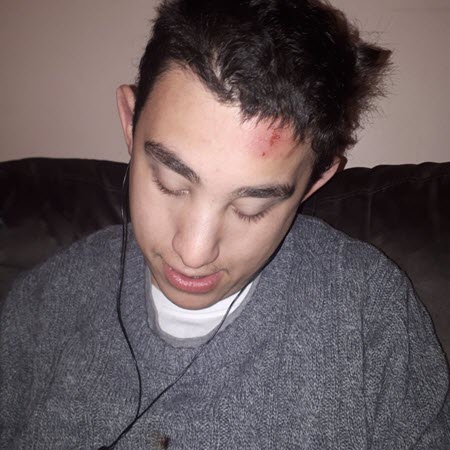
When 26-year-old James Wheatley came home from disability respite care with a lesion on his head, his mother, Anndrea, was shocked. How could no one notice a huge, red bump on his head?
Trying to find out what happened to Wheatley, who is non-verbal, proved to be an impossible task. The care provider launched an internal investigation which revealed nothing.
NSW Police did not investigate. The National Disability Insurance Scheme (NDIS) Quality and Safeguards Commission, the scheme’s watchdog, dismissed Anndrea’s complaint.

With no words, no video cameras at the respite centre, and a regulatory body reluctant to get involved, no progress can be made in preventing what happened to Wheatley from happening again.
How could no one notice Wheatley’s head injury?
Wheatley lives in NSW’s Blue Mountains with his mum, Anndrea, and one of his three sisters. He has a mop of dark hair and looks 10 years younger than he is.
When Wheatley was three, he was diagnosed with an intellectual disability and fragile X syndrome — a genetic disorder with similar traits as autism. He can’t speak, isn’t violent and is steady on his feet.
Wheatley loves listening to music on his iPad. He’s recently made the switch from listening to The Wiggles and Beyonce to classical music.
Wheatley attends respite care twice a week, staying overnight about once a month to socialise with other people with disabilities. Anndrea estimates the centre receives around $60,000 a year, funded through the NDIS, for these visits.
In August last year, Wheatley was dropped home from his day program with a large red bump on his head.
Panicked, his mum called the respite care operator to find out what happened. Staff said they hadn’t noticed the injury and hadn’t filed an incident report, as is required under the NDIS code of conduct when a participant is injured while in care.
“Everyone else could see it, why couldn’t the worker?” Anndrea said.
About 40% of the disability workforce is made up of casual employees. Many new hires in the sector have no disability-related qualifications.
A doctor found the injury was uncomfortable for Wheatley, and had been caused by moderate force, but couldn’t determine if it was self-inflicted or caused by someone else.

Unusually, Wheatley cried the next time carers arrived to take him into the day program. Anndrea kept him home that day.
More than two months after Wheatley was injured, the lesion was still swollen. He used to pat the back of his head out of habit. Now, he taps where the mark was.
“He hits it when he is agitated … I am wondering if he is still upset about being hit and traumatised,” Anndrea said.
Police and provider reluctant to get involved
Anndrea said getting answers about how her son could be injured so badly has been like pulling teeth.
The centre — which Anndrea did not want named — only logged an incident report at her insistence. On agreeing to conduct an internal investigation, they told her it would take weeks and they would “probably find nothing”
Unsatisfied with the centre’s laid back approach toward her son’s head injury, Anndrea went to the police.
She alleges two officers told her that kids get hurt all the time, and mothers always get worked up. The police didn’t visit Wheatley or interview his carer, deciding not to investigate.
The officers initially involved were later cautioned for not dealing with the complaint properly, though the police still chose not to conduct an investigation, citing a lack of evidence.
“Here’s my son with an injury on his head and they weren’t doing anything,” Anndrea said.
One in five Australians has a disability, and 47% of adults with a disability have experienced violence, yet people with disabilities only make up between 2% and 5% of the total recorded victims of crime in Victoria. There is limited national data available.
Swinburne university lecturer in forensic behavioural science Dr Margaret Nixon told Inq police are often reluctant to investigate crimes unless there is a reasonable prospect of conviction.
“If that person is nonverbal, it’s really difficult to get that crime prosecuted,” she said.
Instead of taking statements from the alleged victim, police have to look for collateral evidence — physical signs and statements from others.
This means when it comes to reporting crimes for people with disabilities who have trouble communicating, “the threshold for that reporting is much greater for than you or I,” she said.
“It’s another sign in society that we don’t value the lives and safety of people with disabilities as much as others.”
Commission dismissed complaint
Upset that the police and provider’s response had stalled, two weeks after Wheatley’s injury Anndrea turned to the NDIS Quality and Safeguards Commission.
She submitted a complaint outlining what happened, along with photos.
The commission dropped her complaint after speaking with the provider.
Because the care provider filed an incident report (on Anndrea’s insistence), conducted an internal investigation, identified training needs for staff and moved the care worker who failed to notice the injury, the commission was satisfied the problem was solved.
“The NDIS commission has spoken with [the provider] about their responsibilities and obligations under the code of conduct and NDIS practise standards,” the resolution read.
A second letter to Anndrea shows the commission decided the provider’s investigation and the response was “appropriate and proportionate.”
The support worker was moved from the respite care home, though continued to work within the company.
No one from the commission visited Wheatley.
Speaking generally, commission registrar Samantha Taylor recently told a federal inquiry into the commission that in traumatic instances, the watchdog doesn’t always speak to or visit an alleged victim.
“(In) incidents where there has often been a very traumatic experience for a participant our first port of call would not necessarily be to that participant … Often people don’t want the regulator there when something bad has happened to them,” she said.
Fighting for change
After speaking to the police and lawyers, Anndrea learned that — as Wheatley cannot give evidence as he doesn’t talk — without video footage of what happened there’s no way to find out how her son was injured.
“There should be penalties and punishments for workers who don’t report incidents and punishments for that organisation for failed duty of care,” she said.
Anndrea has written to politicians and created petitions to raise awareness around how difficult it is to investigate injuries in people with disabilities.
She wants cameras to be installed in group homes, for a registry of disability workers found to have abused or neglected clients to ensure they can’t be employed by other agencies, and an extension of the child protection act to protect people with disabilities.
“I must be James’ voice,” she said.








Too easy for everybody but his Mum, Anndrea, to run for cover in this despicable situation. It’s a big slide from “All care. no responsibility” to “NO care, no responsibility”! Unless Anndrea persistently hounds EACH AND EVERY PERSON who might know something about “the large red bump on his head”, to the point that she’s allegedly (by them) obsessed to the point of dementia, this will slip into the cesspit of “unsolved crimes” and be ignored. Bureaucracies have a terrifying ability to hold their own ground against any/all criticism, whenever they’re threatened. Probably best to find a local MP who’ll take up the case on her/their behalf and won’t stop baying until somebody’s prepared to tell the truth about it!
Federal ALP MP Susan Templeman & NSW Labor MLA Trish Doyle would be on this like a shot… if justified.
Too often parentdectomy is the better option.
Isn’t a head lesion ‘evidence’? Oh, that’s scotch mist.
This is good reportage from Ms Schultz.
Pity is, there’s so little response.
Personally, I would have bothered earlier, if not for the mandatory referral to ‘moderation’ that seems to apply fitty plus % of the time (and, for which ‘the bureau’ seems to have given up trying to explain. Algo world! But, bgeugger me, if it ain’t boring).
But, to reiterate, kudos to Ms Schultz – it’s good – and important – work.
If this disabled man was a child who came home from daycare with that sort of injury, the police and the care facility would have been leaping over themselves to find out what happened.
There needs to be more community training and awareness.
I feel you anger on this matter my son came home with deep bruises( finger marks) on inside and outside of his legs and thighs. I went to the police and took photos as did police. After a meeting with the provider they implemented more things that should have been there in first place. I wanted my son to never return so we left but years later after assurances from ceo etc while I was ill in hospital my family sent him on another camp with agency all was fine then months later he came home with a rash that was bleeding etc. More needs to be done for those that don’t have a voice.. If they fail in quality of care for our loved ones then I’m sorry they don’t get a second chance they should loose there licence and have to undergo full training as well as all the staff. If I had my way I would put them through what my son went through and see how they like being treated like that. My son is deaf but gets treated because of that and his other disabilities like he is mentally challenged which he is not he is highly intelligent. Whether he was mentally challenged or like he is all without a voice deserve to be treated the way we all expect to be treated with respect and dignity.